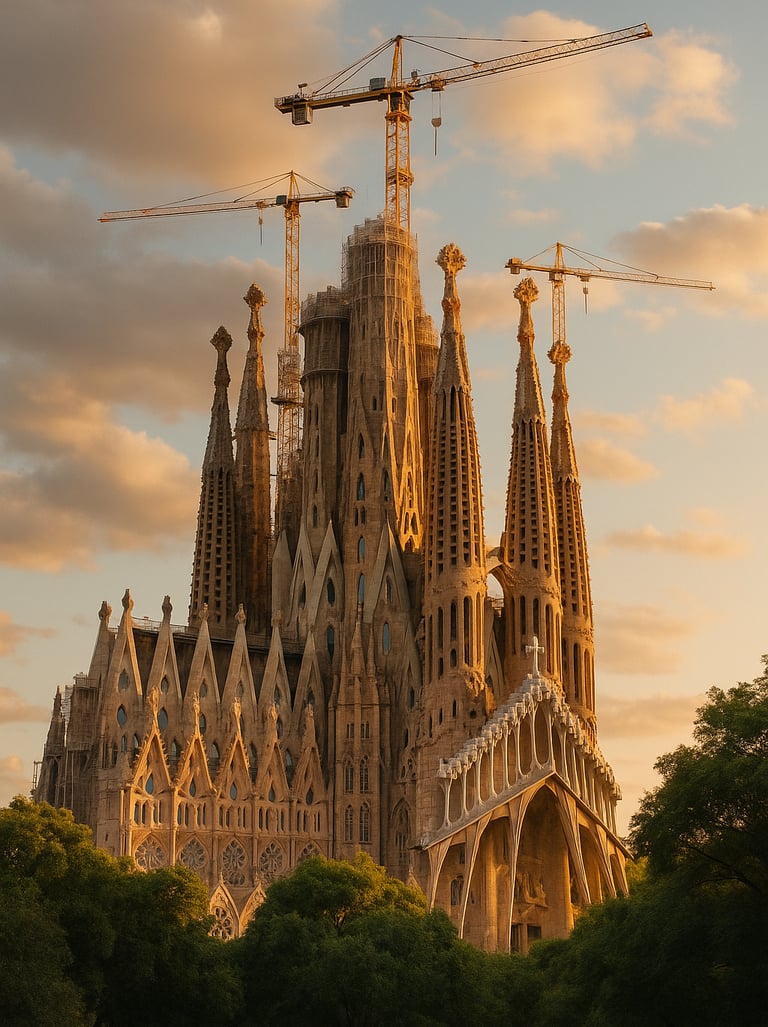La Sagrada Família – The Unfinished Symphony


La Sagrada Família: The Unfinished Symphony
There are buildings that make you stop and stare. Then there's La Sagrada Família, a structure so otherworldly that it seems to have erupted from Barcelona's urban fabric like a fever dream rendered in stone. For over 140 years, this basilica has been rising skyward, and its incomplete state has become part of its mythology. This is architecture as symphony—sprawling, ambitious, and still being composed.
A Vision Born in Stone
When Antoni Gaudí took over the project in 1883, he inherited a conventional neo-Gothic church design. What he delivered instead was something that defied every architectural convention of his time. Gaudí didn't just design a church; he reimagined what sacred space could be. He drew inspiration from nature's own architecture—the branching of trees, the geometry of honeycombs, the spiraling patterns of shells. Walking into La Sagrada Família is like stepping into a petrified forest where columns rise like mighty trees, their branches spreading across the ceiling in a canopy of light and color.
The basilica's exterior tells biblical stories across three grand facades. The Nativity Facade, the only one completed during Gaudí's lifetime, bursts with life and exuberant detail—angels trumpet, animals peek from stone foliage, and the Holy Family emerges from a riot of sculptural energy. The Passion Facade, stark and angular, conveys suffering through its brutal simplicity. The yet-to-be-completed Glory Facade will eventually serve as the main entrance, promising to outshine them all.
The Architect Who Became a Monument
Gaudí's relationship with La Sagrada Família evolved from professional commission to spiritual obsession. In his final years, he abandoned all other projects, moved into a workshop on site, and devoted himself entirely to the basilica. He begged for donations in the streets, lived ascetically, and poured everything into his vision. When he was tragically struck by a tram in 1926, he died as he had lived in those final years—wholly committed to his unfinished symphony.
His death left behind only partial plans, plaster models, and drawings. Many were destroyed during the Spanish Civil War, making the continuation of his work both an act of architectural archaeology and creative interpretation. The architects who followed have had to be part detective, part artist, channeling Gaudí's genius while applying modern engineering and their own sensibilities.
Building a Cathedral in the Age of Skyscrapers
What makes La Sagrada Família remarkable isn't just its beauty but its defiance of time itself. Medieval cathedrals took centuries to build because they had to—technology was limited, labor was manual, and funding was uncertain. La Sagrada Família has taken over a century despite cranes, computers, and modern construction techniques. This isn't architectural inefficiency; it's intentional devotion to craft.
The construction has accelerated dramatically in recent decades. Computer modeling has helped solve structural puzzles that would have taken Gaudí years to work out with string and weights. 3D printing produces intricate stone elements. Yet even with technology's assistance, there's an insistence on traditional craftsmanship, on stone cut by human hands, on details that most visitors will never see but that honor Gaudí's vision.
The current projected completion date hovers around 2026, marking the centennial of Gaudí's death. Whether that deadline holds feels almost beside the point. The basilica has existed in a state of becoming for so long that its incompleteness has become essential to its identity.
An Unfinished Masterpiece or a Complete One?
Here's the paradox: La Sagrada Família has been a UNESCO World Heritage site since 1984, was consecrated as a basilica by Pope Benedict XVI in 2010, and attracts millions of visitors annually—all while technically unfinished. It functions as a church, serves as Barcelona's most iconic landmark, and stands as one of the world's most photographed buildings. In what meaningful sense is it incomplete?
Perhaps the "unfinished" label is less about architectural status and more about philosophical stance. Gaudí himself reportedly said, "My client is not in a hurry," referring to God. The building's ongoing construction reminds us that great works aren't necessarily meant to be completed quickly or perhaps at all. The process itself has value. Each generation that works on La Sagrada Família leaves its mark, contributing to something larger than any individual lifetime.
Why It Still Matters
In an era of instant gratification and viral architecture designed to photograph well and age quickly, La Sagrada Família offers a different model. It's a rebuke to the disposable, a monument to patience, and proof that some things are worth the wait. The basilica challenges our modern assumption that speed equals progress.
Standing inside, looking up at those tree-like columns branching into a canopy of geometric precision, light filtering through stained glass in jeweled tones, you feel the weight of all those years of labor. Every stone was placed by someone who knew they wouldn't see the final result. That collective patience, that multi-generational commitment to a single vision, feels almost alien in our age of quarterly earnings and five-year plans.
La Sagrada Família isn't just Gaudí's masterpiece—it's a meditation on time, faith, and the human impulse to create something that outlasts us. Whether it's completed in 2026 or continues for another century, it will remain what it has always been: a work in progress and a finished masterpiece simultaneously, an unfinished symphony that has already earned its place among the world's greatest compositions.
The scaffolding, the construction cranes, the dust and noise of ongoing work—they're not obstacles to appreciating La Sagrada Família. They're part of the performance.
Retry
